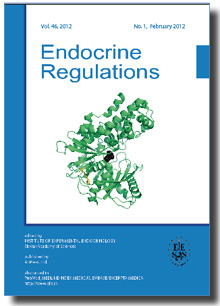Journal info
|
||
Select Journal
Journals
Bratislava Medical Journal Ekologia - Ecology Endocrine Regulations 2015 2014 2013 2012 2011 2010 2009 2008 2007 2006 2005 2004 2003 General Physiology and Biophysics Neoplasma Acta Virologica Studia Psychologica Cardiology Letters Psychológia a patopsych. dieťaťa Kovove Materialy-Metallic Materials Slovenská hudba 2025Webshop Cart
Your Cart is currently empty.
Info: Your browser does not accept cookies. To put products into your cart and purchase them you need to enable cookies.
Endocrine Regulations Vol.44, No.1, p.3-8, 2010 |
||
| Title: Changes of metabolic profile in men treated for androgenetic alopecia with 1 mg finasteride | ||
| Author: M. Duskova, M. Hill, L. Starka | ||
| Abstract: Objective. Androgenetic alopecia is recognized as a risk factor for cardiovascular diseases, glucose metabolism disorders, and benign prostate hyperplasia and/or carcinoma. Finasteride, used for treatment of androgenetic alopecia at a dose of 1mg/day, is an effective inhibitor of type II 5α-reductase, the enzyme responsible for the reduction of testosterone to dihydrotestosterone. Recent studies reported that dihydrotestosterone, among other activities, might play some role in visceral fat metabolism. It thus seemed reasonable to examine whether finasteride treatment of androgenetic alopecia ameliorates some features of metabolic syndrome frequently seen associated with this condition. Methods. We examined 12 men with premature balding (defined as frontoparietal and vertex hair loss before age 30 with alopecia defined as grade 3 vertex or more on the Norwood-modified Hamilton alopecia classification). Hormonal levels and metabolic parameters were determined and insulin tolerance tests performed for all individuals. Finasteride (1 mg/day) was administrated for 12 months. The hormonal profile and lipid spectrum were monitored after 4, 8 and 12 months of treatment and insulin tolerance tests were repeated after 12 months of the treatment. Results. After treatment with finasteride the expected changes in the steroid spectrum were seen, namely a decrease in dihydrotestosterone and increase in testosterone, androstenedione and free testosterone index. We observed an initial increase in total cholesterol and HDL- and LDL-cholesterol, which stabilized with prolonged treatment. We founded a significant decrease in glycated hemoglobin HbA1c and insulin resistance measured using rate constant for plasma glucose disappearance (kITT) showed only a borderline decrease. Conclusions. Finasteride is an efficient 5α-reductase inhibitor even at low doses of 1mg/day. In men treated with this dose for 12 months, we observed mild differences in metabolic profile with slight amelioration of glucose metabolism regulation. |
||
| Keywords: Finasteride – Androgenetic alopecia – Androgens – Lipids – Insulin sensitivity – Metabolic disorders | ||
| Year: 2010, Volume: 44, Issue: 1 | Page From: 3, Page To: 8 | |
| doi:10.4149/endo_2010_01_3 |
||
|
Price:
12.00 €
|
||
|
|
||

